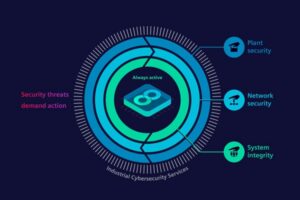Gascade Gastransport GmbH is responsible for safe operation of the landfall station of the Nord Stream pipeline at the Lubminer Heide energy centre near Greifswald in Germany. Effective lightning and surge protection measures have been implemented there to ensure a reliable supply even in a thunderstorm with all the accompanying interference.
The authors: Ralf Hartmann Systems Engineering EMSR, Gascade Reiner Kerschbaum Junior Market Manager Process Market Management, Dehn
The Lubminer Heide landfall station is the logistical link between the Nord Stream pipeline and the European gas pipeline network. The gas starts its journey in the Western Siberian town of Vyborg – some 760 miles away. When it arrives in Lubmin, Germany, it is cleaned of impurities and heated to prevent condensation before being transported through the OPAL (Baltic Sea pipeline link) and NEL (North European gas pipeline) pipelines into the European gas pipeline network.
Eleven months after the first Nord Stream pipeline was put into operation (November 2011), the second line was officially inaugurated on October 8, 2012. These two pipelines transport up to 55 billion cubic metres of gas a year from Western Siberia to Europe – enough to satisfy more than half of Germany’s annual natural gas demand (96.26 billion cubic metres in 2010). This mega project, in which 51 % of the consortium shares are held by Gazprom, 15.5 % each by Wintershall Holding GmbH and e.on Ruhrgas AG as well as 9 % each by Gasuine and GDF SUEZ, was completed on time and within the allotted budget (7.4 billion euros) after a construction period of only 30 months.
Effective lightning and surge protection measures were implemented to ensure a reliable supply even in a thunderstorm with all the accompanying interference. The action taken was based on the results of a risk analysis in conformity with IEC 62305-2. All possible risks were considered and technically and economically sound measures incorporated to reduce the residual risk to an acceptable level. The underlying principle of these measures was to eliminate field-based and conducted interference as far as possible. This is achieved by subdividing the structure into so-called lightning protection zones (LPZ) and realising appropriate LEMP protection measures (SPM). The lightning protection zone concept according to IEC 62305-4 defines suitable zones depending on the plant size as well as the type and sensitivity of the electronic systems. LPZ 0A denotes areas which are subject to direct lightning strikes and high impulse currents up to full lightning impulses where the full lightning electromagnetic field is present. LPZ 0B areas, which are protected from direct lightning strikes but where the full electro-magnetic field is present, are created by installing air termination systems. In the inner zones from LPZ 1 to LPZ n, all incoming conductive parts are connected to the equipotential bonding system at the zone boundaries and conducted interference reduced by suitable surge protective devices.
Adequate shielding measures can be provided according to the immunity of the electronic systems to be protected in order to attenuate the lightning electromagnetic field.
Safe equipotential bonding
As a basic equipotential bonding measure, a meshed earth termination system was installed at the landfall station to distribute the lightning current evenly in the soil and prevent potential differences or sparkover – particularly in potentially explosive atmospheres.
Given that very high demands are made on the availability of the pipeline, special emphasis was placed on the protection of the process control system. The entire process is visualised while the physical gas flow is controlled by means of filters and preheating facilities with governors according to operational requirements. To this end, Profibus DP was installed in the Greifswald landfall station for the first time as an integrated fieldbus. The incoming Profibus lines from the actuators in the field are routed to the distribution board via the surge arresters installed at the LPZ 0A to 1 zone boundaries. From there, the connection is fed over the Siemens Y link to highly available Simatic S7-400H CPUs.
The cable shields of the incoming field lines are installed on an anchor bar at their entry into the switchgear cabinet for direct earthing. The shielding concept is based on one-sided earth-ing which does not attenuate the interference field in the event of lightning-induced pulses. Highly efficient arresters were chosen for this task.
Combined lightning current and surge arresters in the Blitzductor XT product family were used for this Profibus application. These pluggable arresters combine a high lightning impulse current discharge capacity with an extremely low voltage protection level to ensure efficient protection of terminal equipment. The protective circuit for high-frequency signals, which fulfils all Profibus requirements, permits permanent bus communications without negatively affecting the performance and transmission reliability of the Profibus.
Easy maintenance
To facilitate maintenance, LifeCheck monitoring technology enables the status of the surge arresters to be checked quickly and easily. An early warning system allows the LifeCheck feature to detect potential electrical or thermal damage to the protection modules within a matter of seconds with the help of contactless RFID technology. If a pre-damaged module is detected, it can be simply replaced during operation thanks to its modular design.
All live parts are housed in the pluggable mod-ule, so that no wiring is required and communication on the pair to be protected is not interrupted.
To make sure this protection concept is consistently implemented, all other lines entering buildings that house control rooms or systems are protected by surge arresters, namely all 230/400 V power supply lines, all 24 V(DC) supply lines for programmable logic controllers, telecommunication connections and the lines of intrinsically safe circuits for a series of measuring sensors as well as safety systems such as gas detectors and fire alarms.
cpp-net.com/0213418
Share:






